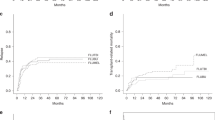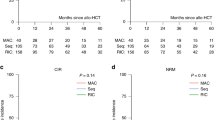Abstract
There is substantial need to improve the outcome of patients with high-risk acute myeloid leukemia (AML). The clinical trial reported here investigated a new approach of up-front allogeneic hematopoietic stem cell transplantation (HSCT), provided a median of 40 days (range 22–74) after diagnosis, in twenty-six consecutive patients with newly-diagnosed high-risk AML characterized by poor-risk cytogenetics (n=19) or inadequate blast clearance by induction chemotherapy (IC, n=7). The median age was 49 years (range 17–68). During IC-induced aplasia after the 1st (n=11) or 2nd (n=15) cycle, patients received allogeneic peripheral blood stem cells (PBSC) from related (n=11) or unrelated (n=15) donors following a fludarabine-based reduced-intensity regimen. Seventeen patients were not in remission before HSCT with a median marrow blast count of 34% (range 6–70). All patients achieved rapid engraftment and went into remission with complete myeloid and lymphatic chimerism. Grades II to IV acute GvHD occurred in 14 (56%) and extensive chronic GvHD was documented in 8 (35%) patients. The probability of disease-free survival was 61% with only three patients relapsing 5, 6 and 7 months after transplantation, respectively. Up-front allogeneic HSCT as part of primary induction therapy seems to be an effective strategy in high-risk AML patients and warrants further investigation.
This is a preview of subscription content, access via your institution
Access options
Subscribe to this journal
Receive 12 print issues and online access
$259.00 per year
only $21.58 per issue
Buy this article
- Purchase on Springer Link
- Instant access to full article PDF
Prices may be subject to local taxes which are calculated during checkout



Similar content being viewed by others
References
Grimwade D, Walker H, Oliver F, Wheatley K, Harrison C, Harrison G et al. The importance of diagnostic cytogenetics on outcome in AML: analysis of 1612 patients entered into the MRC AML 10 trial. The Medical Research Council Adult and Children's Leukaemia Working Parties. Blood 1998; 92: 2322–2333.
Byrd JC, Mrozek K, Dodge RK, Carroll AJ, Edwards CG, Arthur DC et al. Pretreatment cytogenetic abnormalities are predictive of induction success, cumulative incidence of relapse, and overall survival in adult patients with de novo acute myeloid leukemia: results from Cancer and Leukemia Group B (CALGB 8461). Blood 2002; 100: 4325–4336.
Slovak ML, Kopecky KJ, Cassileth PA, Harrington DH, Theil KS, Mohamed A et al. Karyotypic analysis predicts outcome of preremission and postremission therapy in adult acute myeloid leukemia: a Southwest Oncology Group/Eastern Cooperative Oncology Group Study. Blood 2000; 96: 4075–4083.
Suciu S, Mandelli F, de Witte T, Zittoun R, Gallo E, Labar B et al. Allogeneic compared with autologous stem cell transplantation in the treatment of patients younger than 46 years with acute myeloid leukemia (AML) in first complete remission (CR1): an intention-to-treat analysis of the EORTC/GIMEMAAML-10 trial. Blood 2003; 102: 1232–1240.
Drobyski WR . The role of allogeneic transplantation in high-risk acute myelogenous leukemia. Leukemia 2004; 18: 1565–1568.
Cassileth PA, Harrington DP, Appelbaum FR, Lazarus HM, Rowe JM, Paietta E et al. Chemotherapy compared with autologous or allogeneic bone marrow transplantation in the management of acute myeloid leukemia in first remission. N Engl J Med 1998; 339: 1649–1656.
Schlenk RF, Benner A, Hartmann F, del Valle F, Weber C, Pralle H et al. Risk-adapted postremission therapy in acute myeloid leukemia: results of the German multicenter AML HD93 treatment trial. Leukemia 2003; 17: 1521–1528.
Kern W, Haferlach T, Schoch C, Loffler H, Gassmann W, Heinecke A et al. Early blast clearance by remission induction therapy is a major independent prognostic factor for both achievement of complete remission and long-term outcome in acute myeloid leukemia: data from the German AML Cooperative Group (AMLCG) 1992 Trial. Blood 2003; 101: 64–70.
Hansen JA, Gooley TA, Martin PJ, Appelbaum F, Chauncey TR, Clift RA et al. Bone marrow transplants from unrelated donors for patients with chronic myeloid leukemia. N Engl J Med 1998; 338: 962–968.
Bensinger WI, Martin PJ, Storer B, Clift R, Forman SJ, Negrin R et al. Transplantation of bone marrow as compared with peripheral-blood cells from HLA-identical relatives in patients with hematologic cancers. N Engl J Med 2001; 344: 175–181.
Horan JT, Liesveld JL, Fernandez ID, Lyman GH, Phillips GL, Lerner NB et al. Survival after HLA-identical allogeneic peripheral blood stem cell and bone marrow transplantation for hematologic malignancies: meta-analysis of randomized controlled trials. Bone Marrow Transplant 2003; 32: 293–298.
Platzbecker U, Thiede C, Freiberg-Richter J, Rollig C, Helwig A, Schakel U et al. Early allogeneic blood stem cell transplantation after modified conditioning therapy during marrow aplasia: stable remission in high-risk acute myeloid leukemia. Bone Marrow Transplant 2001; 27: 543–546.
Schaich M, Illmer T, Seitz G, Mohr B, Schakel U, Beck JF et al. The prognostic value of Bcl-XL gene expression for remission induction is influenced by cytogenetics in adult acute myeloid leukemia. Haematologica 2001; 86: 470–477.
Schuler US, Renner UD, Kroschinsky F, Johne C, Jenke A, Naumann R et al. Intravenous busulphan for conditioning before autologous or allogeneic human blood stem cell transplantation. Br J Haematol 2001; 114: 944–950.
Platzbecker U, Prange-Krex G, Bornhauser M, Koch R, Soucek S, Aikele P et al. Spleen enlargement in healthy donors during G-CSF mobilization of PBPCs. Transfusion 2001; 41: 184–189.
Thiede C, Bornhauser M, Oelschlagel U, Brendel C, Leo R, Daxberger H et al. Sequential monitoring of chimerism and detection of minimal residual disease after allogeneic blood stem cell transplantation (BSCT) using multiplex PCR amplification of short tandem repeat-markers. Leukemia 2001; 15: 293–302.
Bornhauser M, Thiede C, Platzbecker U, Jenke A, Helwig A, Plettig R et al. Dose-reduced conditioning and allogeneic hematopoietic stem cell transplantation from unrelated donors in 42 patients. Clin Cancer Res 2001; 7: 2254–2262.
Przepiorka D, Weisdorf D, Martin P, Klingemann HG, Beatty P, Hows J et al. 1994 Consensus Conference on Acute GVHD Grading. Bone Marrow Transplant 1995; 15: 825–828.
Shulman HM, Sullivan KM, Weiden PL, McDonald GB, Striker GE, Sale GE et al. Chronic graft-versus-host syndrome in man. A long-term clinicopathologic study of 20 Seattle patients. Am J Med 1980; 69: 204–217.
Kaplan ELMP . Nonparametric estimator from incomplete observations. Journal of American Statistical Association 1958; 53: 457–481.
Lin DY . Non-parametric inference for cumulative incidence functions in competing risks studies. Stat Med 1997; 16: 901–910.
Thiede C, Steudel C, Mohr B, Schaich M, Schakel U, Platzbecker U et al. Analysis of FLT3-activating mutations in 979 patients with acute myelogenous leukemia: association with FAB subtypes and identification of subgroups with poor prognosis. Blood 2002; 99: 4326–4335.
Kottaridis PD, Gale RE, Linch DC . Prognostic implications of the presence of FLT3 mutations in patients with acute myeloid leukemia. Leuk Lymphoma 2003; 44: 905–913.
Stelljes M, Bornhauser M, Kroger M, Beyer J, Sauerland MC, Heinecke A et al. Conditioning with 8 Gy total body irradiation and fludarabine for allogeneic hematopoietic stem cell transplantation in acute myeloid leukemia. Blood 2005; 106: 3314–3321.
Platzbecker U, Ehninger G, Schmitz N, Bornhauser M . Reduced-intensity conditioning followed by allogeneic hematopoietic cell transplantation in myeloid diseases. Ann Hematol 2003; 82: 463–468.
Hegenbart U, Niederwieser D, Sandmaier BM, Maris MB, Shizuru JA, Greinix H et al. Treatment for Acute Myelogenous Leukemia by Low-Dose, Total-Body, Irradiation-Based Conditioning and Hematopoietic Cell Transplantation From Related and Unrelated Donors. J Clin Oncol 2005, Dec 12 (epub ahead of print).
Bornhauser M, Storer B, Slattery JT, Appelbaum FR, Deeg HJ, Hansen J et al. Conditioning with fludarabine and targeted busulfan for transplantation of allogeneic hematopoietic stem cells. Blood 2003; 102: 820–826.
Kottaridis PD, Milligan DW, Chopra R, Chakraverty RK, Chakrabarti S, Robinson S et al. In vivo CAMPATH-1H prevents graft-versus-host disease following nonmyeloablative stem cell transplantation. Blood 2000; 96: 2419–2425.
Sorror ML, Maris MB, Storer B, Sandmaier BM, Diaconescu R, Flowers C et al. Comparing morbidity and mortality of HLA-matched unrelated donor hematopoietic cell transplantation after nonmyeloablative and myeloablative conditioning: influence of pretransplantation comorbidities. Blood 2004; 104: 961–968.
Morgan J, Wannemuehler KA, Marr KA, Hadley S, Kontoyiannis DP, Walsh TJ et al. Incidence of invasive aspergillosis following hematopoietic stem cell and solid organ transplantation: interim results of a prospective multicenter surveillance program. Med Mycol 2005; 43 (Suppl 1): S49–S58.
Thomas ED . The use and potential of bone marrow allograft and whole-body irradiation in the treatment of leukemia. Cancer 1982; 50: 1449–1454.
Bertz H, Potthoff K, Finke J . Allogeneic stem-cell transplantation from related and unrelated donors in older patients with myeloid leukemia. J Clin Oncol 2003; 21: 1480–1484.
Spyridonidis A, Bertz H, Ihorst G, Grullich C, Finke J . Hematopoietic cell transplantation from unrelated donors as an effective therapy for older patients (> or = 60 years) with active myeloid malignancies. Blood 2005; 105: 4147–4148.
Schmid C, Schleuning M, Ledderose G, Tischer J, Kolb HJ . Sequential regimen of chemotherapy, reduced-intensity conditioning for allogeneic stem-cell transplantation, and prophylactic donor lymphocyte transfusion in high-risk acute myeloid leukemia and myelodysplastic syndrome. J Clin Oncol 2005; 23: 5675–5687.
Jourdan E, Maraninchi D, Reiffers J, Gluckman E, Rio B, Jouet JP et al. Early allogeneic transplantation favorably influences the outcome of adult patients suffering from acute myeloid leukemia. Societe Francaise de Greffe de Moelle (SFGM). Bone Marrow Transplant 1997; 19: 875–881.
Acknowledgements
We would like to thank the German bone marrow donor center (DKMS) for promoting the ‘fast search donor program’. This work was supported in part by grants of the Deutsche Krebshilfe 70-3197 (MB and CT) and 70-2980 (MB), presented orally as abstract at the EBMT meeting in Barcelona 2003.
Author information
Authors and Affiliations
Corresponding author
Rights and permissions
About this article
Cite this article
Platzbecker, U., Thiede, C., Füssel, M. et al. Reduced intensity conditioning allows for up-front allogeneic hematopoietic stem cell transplantation after cytoreductive induction therapy in newly-diagnosed high-risk acute myeloid leukemia. Leukemia 20, 707–714 (2006). https://doi.org/10.1038/sj.leu.2404143
Received:
Revised:
Accepted:
Published:
Issue Date:
DOI: https://doi.org/10.1038/sj.leu.2404143
Keywords
This article is cited by
-
Allogeneic hematopoietic cell transplantation for older patients with AML with active disease. A study from the Acute Leukemia Working Party of the European Society for Blood and Marrow Transplantation (EBMT)
Bone Marrow Transplantation (2024)
-
Clofarabine salvage therapy before allogeneic hematopoietic stem cell transplantation in patients with relapsed or refractory AML: results of the BRIDGE trial
Leukemia (2016)
-
Hematopoietic cell transplantation in patients with intermediate and high-risk AML: results from the randomized Study Alliance Leukemia (SAL) AML 2003 trial
Leukemia (2015)
-
A novel clofarabine bridge strategy facilitates allogeneic transplantation in patients with relapsed/refractory leukemia and high-risk myelodysplastic syndromes
Bone Marrow Transplantation (2013)
-
Early intervention with allogeneic hematopoietic cell transplantation during chemotherapy-induced aplasia in patients with high-risk acute myeloid leukemia
Leukemia (2013)



